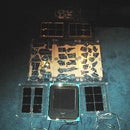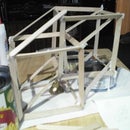Introduction: Make a Brass Soldering Iron Tip (, How I ...)
Well I don't have a very well tooled machine shop at all,
but my first soldering iron had a brass or bronze tip,
and other people have remarked about how new tips
don't last as long as rare or unobtainable brass ones
from times gone by.
I can't say how good this is yet since I just made it
and will compare it to the other tips as far as wearing
out goes. Brass is supposed to be copper and zinc,
but just about any other yellow alloy using copper
may also be called brass, and dark coppers bronze.
Another reason I want to make soldering tips is that
I plan to try to make a very tiny soldering iron for SMD's
that I will have to solder under a microscope for
interesting one-time projects. One such project
may be phonographic (sounds groovy!) in nature.
Step 1: What You Need
Tools and Parts. Here are the ones I used:
1.A regular moderately cheap soldering iron.
(not the 99 cent ones that melt in your hand though)
2.A brass rod similar in diameter to the iron's non-brass tip.
3.A rotary motor tool kit like a dremel.
4.safety glasses
5.solder
6.flux
7.Something not very important to solder the first time.
Step 2: About Two Different Ways
I did it two different ways by forgetting how I did it first.
Probably the easiest way is to grind or taper one end
of a long brass rod and then make rough "threads"
similar to the ones the original non-brass tip has,
screw it into the soldering iron, cut it off an inch or so,
and then sharpen the end that was just separated from
the rod. To make a long story short that's how I made
the first tip.
But I'll continue with the "hard way" because it has
similar steps that may be important details. The hard way
is to sharpen it first, cut it off, and then thread it.
If you have a nut or die it may help, but grinding away
at the Slightly tapered and crudely threaded end is what
I did to make the brass tip screw into the soldering iron.
The hard way is sharpening the end of the rod as the
soldering tip end First. Details follow. Both ways are
probably wrong in the mind of a machinist, but they
made tips, so they do work.
Step 3: Making the Tip the Harder Way...
Here I shined up the brass rod which was temporarily used
as part of an antenna, using steel wool. There are probably
other ways to shine it up, like buffing or using something called
"brasso". Feel free to comment on my unskilled machining "errors"
and what better ways are the best.
Then I sharpened the end of the rod, in a shape that's good for
soldering. Pointy, and kind of flat.
This is the "hard way" tip. The "easy way" tip was just cut at a
sharp diagonal leaving an elliptical facet on the soldering end.
Then I compared the size of the original tip to the rod and
cut it off there.
Then I "scored" and slightly tapered the cut off end of the new
brass tip I'm making and using vise-grips, cut screw-thread-like
slightly diagonal notches in a roughly spiral pattern. (In the
"easy way" I did this first and screwed it into the iron before
cutting it off.)
Step 4: Getting the Tip Ready to Solder
Again the easy tip was made into a screw at one end of the brass rod,
screwed into the soldering iron, and then cut off of the rest of the rod.
It was also polished shiny. (I haven't used the hard-way tip yet.)
Then I dipped the tip halfway into flux, wrapped it up in high-tin solder
(with no lead, just because it seemed like a good idea to "tin" it),
and plugged in the soldering iron with the brass tip. The solder melted
as it heated up and I added more, coating about half the brass with
the tin. Regular rosin core solder can probably also be used. This is
a totally experimental make anyway, so if it works it works.
Step 5: Trying It Out - Solder a Job
I decided to use this to fix an old invention that has no
practical purpose that I made in my youth, which has
old Germanium transistors that must have shorted out.
It's a weird circuit that buzzed if you touch it.
So far, the soldering brass seems great.
Step 6: Check the Condition of the Tip After Use
The oval tapered soldering tip surface still seems nice and flat and shiny!
I wonder how long it will last.
Remember, this is a totally unskilled experiment in soldering-tip-makeing.
Results may vary, Comments welcome! Are brass tips better or not?













